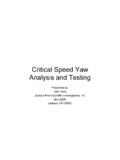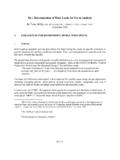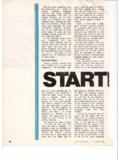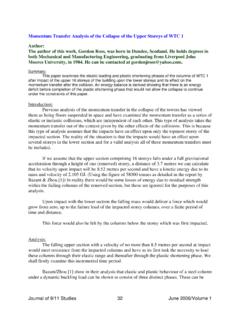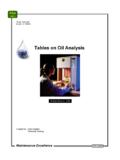Transcription of Torsional Vibration Measurement and Analysis of …
1 Measurement and Analysis of Torsional Vibration Improved Approaches to the Measurement and Analysis of Torsional Vibration Se n Adamson, Rotec GmbH, Munich Abstract Introduction A primary goal of NVH engineering is the identifica- Understanding and controlling Torsional Vibration is tion and control of noise and Vibration sources. In re- of profound importance in vehicle development, re- cent years the Torsional Vibration behaviour of engine finement and optimisation. The primary source of tor- and powertrain components has gained in signifi- sional Vibration is the internal combustion engine. Pe- cance. This paper discusses several aspects of riodic combustion impulses result in rotational speed measuring and analysing Torsional Vibration and re- fluctuations of the crankshaft. Ignition and combus- lated data. Several Torsional Vibration Measurement tion within a cylinder cause a rapid rise in gas pres- techniques are presented, together with remarks on sure and an angular acceleration of the crankshaft.
2 Precautions against possible sources of error, and Gas compression in the next cylinder causes imme- the order of accuracy to be expected of the test re- diate deceleration. Torque pulsations result in crank- sults. Two applications requiring multichannel meas- shaft Torsional vibrations which reach the camshaft(s). urement and Analysis are outlined. and auxiliaries via belt or chain drives. In addition, the Torsional vibrations which enter the gearbox may be transmitted further via propeller shafts and differen- tials to the vehicle wheels [1, 2, 3]. Increasing demands to shorten development cycles mean that less time is available for both testing and mathematical modelling. Meaningful solutions may not be arrived at by treating Vibration dampers, tim- ing belts, gear stages, etc. as isolated components. Comprehensive studies of the complete system are required which take interactions between individual components into account.
3 Rotec GmbH was formed in 1988 to develop portable, PC-based equipment for use in Torsional Vibration testing. The company places high emphasis on accurate acquisition of tor- sional Vibration data and the primary Analysis meth- ods are based on the revolution domain as opposed 23. Measurement and Analysis of Torsional Vibration to the time domain. In recent years the company has ger cars, as well as trucks and buses. RAS systems exploited both the increased computational power of are modular (both hardware and software), scalable PCs and digital signal processing technology to help to fit operational needs and used both in test cell and make multichannel Measurement and Analysis quick- in-vehicle applications. Figure 1 summarises NVH. er and more effective. This paper begins by present- signal types and sources. ing the new generation of ROTEC-RAS equipment (RAS = Rotation Analysis System).
4 Torsional Vibration Measurement methods are then reviewed. Sources of error are highlighted and the degree of accuracy of test results is discussed. Two applications in en- gine and powertrain testing are utilised to illustrate the capabilities of the equipment. The New Range of RAS Equipment Applications requiring multichannel Torsional vibra- tion Measurement include optimising engine timing and auxiliary drive systems, tuning of Vibration dampers, minimising clutch slip, reducing gearbox rattle and transmission error testing of gearsets. This type of testing may also require additional measure- Figure 1 Test Vehicle, Signals and RAS System ment of transverse vibrations synchronous to the ro- tational data [4, 5]. All RAS channels operate on a common time-base making accurate, phase- Angular Velocity Measuring Methods matched, cross-channel analyses possible ( ac- The digital Measurement technique for Torsional vi- curate calculation of the angular displacement be- bration is based on sampling at equidistant angular tween two rotating shafts).
5 The RAS rotational speed intervals around the rotating shaft. This is generally channels require square-wave TTL level signals as accomplished by one of three methods: (i) mounting input. The time interval between rising (or falling) an incremental rotary encoder onto the shaft, (ii). edges for each pulse period is measured using a scanning a toothed wheel with a magnetic pickup, high-speed counter/timer (10 GHz/40-bit). Input of (iii) targeting reflective/non-reflective (black/white). index pulse and rotational direction signals is also bar patterns with an optical sensor. The sensor elec- provided for. The RAS analogue channels sample at tronics generate an angular velocity signal in the form either 50kHz or 400kHz with 16-bit resolution. Digital of a TTL pulse train. The frequency of the pulse train downsampling, anti-aliasing protection, programma- is directly proportional to the angular velocity of the ble gain, AC/DC coupling and differential or ICP in- shaft.
6 Rotary encoders with high line counts, as used puts are provided. By making use of a commercially in single flank testing of gearsets, can provide thou- available interface board, Controller Area Network sands of pulses per revolution, whereas proximity (CAN) signals may be directly input and analysed in sensors are limited to a maximum of several hundred a similar way to analogue signals. CAN information is pulses per revolution. increasing in relevance since this is the dominating Angular sampling provides a fixed number of sam- serial bus system for in-vehicle networks of passen- ples per revolution and is independent of the rota- 24. Measurement and Analysis of Torsional Vibration tional speed. When time sampling is used, the num- Measuring Pulse Train Periods ber of measure-ment values per revolution varies A high number of clock counts per pulse period al- with rotational speed.
7 A primary advantage of revolu- lows Measurement of pulse train periods with an ac- tion domain Analysis is the elimination of leakage er- curacy of 1 count (quantisation error, assuming no rors from spectral components that are order related. clock jitter). Even for encoders with high line counts Assuming that the angular velocity is constant be- rotating at high speeds, the RAS 10 GHz speed- tween adjacent pulses, the instantaneous angular ve- channel clock ensures a high number of 100psec in- locity values may be calculated by dividing the actu- crements between adjacent pulse train edges. Con- al angular spacing of the physical steps (between sider an encoder with 4500 lines rotating at 6000rpm. gear teeth or encoder lines) by the elapsed time from The pulse frequency is 450kHz (period = ). one positive edge to the next (T1, T2, T3, ) as shown and the number of increments per period is in Figure 2.
8 (10 GHz / 450kHz) = x 105 counter increments This corresponds to a percentage error of 4x10-6%. and may therefore be neglected. Indeed, the RAS. angular resolution of the order of milli arc seconds at typical rotational speeds greatly exceeds the measuring uncertainty of even the best rotary en- coders available today which are specified to sever- Figure 2 Standard Rotational-Speed Pulse Train al seconds of arc. Since the RAS time resolution vast- ly exceeds the accuracy of all angular velocity sen- Figure 2: Standard Rotational-Speed Pulse Train sor arrangements, the error associated with measur- The RAS counter/timer frequency of 10 GHz per ing pulse train periods is negligible. channel (corresponding to a 100ps time base) re- sults in an extremely high angular resolution, , Sensor Movement which is given by Vibration of the proximity sensor in a direction paral- lel to the target teeth or reflecting pattern produces a (1).
9 Signal that is indistinguishable from angular velocity with the angular velocity, w, in degrees/sec and in fluctuations. This error can be eliminated by making degrees. For example, the angular velocity of a shaft the sensor mount stiff enough so that sensor vibra- rotating at 2400 rpm (40Hz) is 7200 deg/s corre- tion is above any angular velocity signal of interest. sponding to an angular resolution of deg. Relative movement between the target and the prox- imity sensor during a Measurement can have two Sources of Error in Angular Velocity main causes: The target may move nearer to or fur- Measurements ther away from the sensor when the shaft is subject- There are three main causes of innaccuracies in an- ed to particular loads. Compared to the normal state, gular velocity measurements: the sensor will encounter a tooth/reflecting marking 1. Errors in measuring pulse train periodic times either too soon or too late and this results in incorrect 2.
10 Errors due to sensor Vibration or relative movement angular velocity values. A second cause is when between proximity sensor and target toothed wheels or optical targets are mounted ec- 3. Errors due to variations in tooth spacing centrically. A 1st order signal is produced which can- 25. Measurement and Analysis of Torsional Vibration not be distinguished from a genuine 1st order pro- duced by machine vibrations. In order to distinguish between first order machine problems and 1st order imbalance two sensors can be positioned 180 de- grees radially opposite to one another. By taking the average value of the two angular velocity signals, the 1st order signal components produced by eccentri- city are eliminated. Tooth Spacing Variation All toothed wheels and gears have some degree of Figure 3 Pattern of Tooth Spacing Variation variation in tooth spacing. A toothed wheel and mag- netic sensor arrangement will generally provide less accurate angular velocity Measurement results than a shaft encoder.

